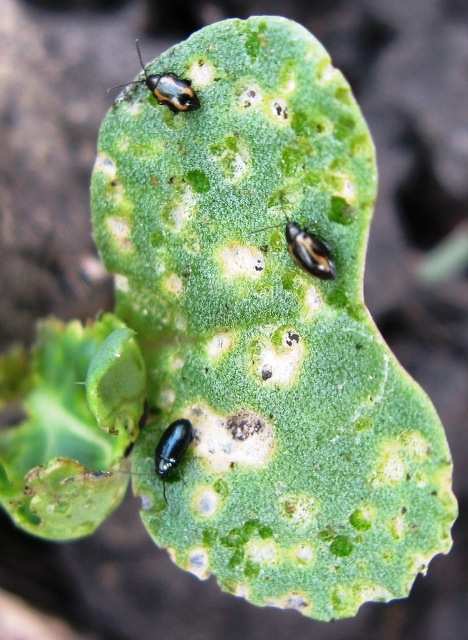Manitoba Insect & Disease Update
Issue 2: May 31, 2017
Summary
Insects: Insect pest concerns are currently low overall.
There have been some insecticide applications for cutworms on corn and soybeans in the Central Region, and on peas and lentils in the Northwest. Some species of cutworms, such as dingy cutworm, have started to turn to pupae in some field. Cutworm staging can be quite variable depending on the dominant species in a field, and the temperatures in the region.
There have also been some insecticide applications for flea beetles in canola, mainly in the Central and Northwest Regions.
Flea Beetle Monitoring Tips
What feeding looks like: Flea beetles will make pits in cotyledons, young leaves, and at times on the stems of canola seedlings. Initially fresh pits may be green, but eventually turn a light brown, and holes may appear (Figure 1). It is the extent of this feeding that needs to be monitored.

Figure 1. Striped flea beetles (top2) and crucifer flea beetle (bottom).
Threshold: Some pitting is normal, even if the seed treatments are still at levels that kill flea beetles. The flea beetles need to consume a small amount of tissue to be killed. As a guideline, when about 25% of the surface area of the cotyledons and true leaves have been damaged, and flea beetles are present, an insecticide would likely be economical.
Consider the crop stage: Once the third and fourth true leaves are expanded, the canola will likely be able to compensate for any remaining flea beetle feeding.
Weather considerations: Flea beetles feed most actively on canola when the weather is sunny, warm, and dry. Cool damp weather reduces the intensity of feeding and aids plant growth.
Forms for Submitting Samples and Images
Samples or images of pathogens, weeds, insects, or crop damage sent to Manitoba Agriculture for identification need to be accompanied by the appropriate form. Crop and location information can help with the diagnosis and provide data on where specific organism are occurring.
There is a form for insect - weed identification, and a separate form for diseases and general diagnostics. These are fillable pdf forms. So they can be opened, filled out, saved, and either Emailed or sent with a sample or image. Please use these anytime a request for diagnostics, either picture or sample, is sent to Manitoba Agriculture. Diagnosis will not commence unless the completed form is attached.
Insect Monitoring Programs
Bertha Armyworm: A reminder for those setting up traps to monitor adults of bertha armyworm that traps should be set up the week of June 5 to 10.
Diamondback Moth: Diamondback moth monitoring with the pheromone baited traps has been underway since the beginning of May. Some moths have been caught in the traps, but levels so far have been low. Out of 84 traps, 41 had cumulative counts of 0 as of May 31. Table 1 below summarizes the highest cumulative counts in Manitoba.
Table 1. Highest cumulative trap counts for diamondback moth adults over the trapping period May 1 to May 20, 2017.
| Location | Count |
|---|---|
| Lockport | 16 |
| Ste. Elizabeth | 15 |
| Ste. Agathe | 11 |
| Minitonas | 8 |
| Rosenort | 7 |
| St. Adolphe | 6 |
A more detailed update of diamondback moth counts in Manitoba is available in the Manitoba Agriculture website at: http://www.gov.mb.ca/agriculture/crops/insects/diamondback-moth-forecast.html
---------------------------------------------------------------------------------------------------------------------------------------------
Compiled by:
John Gavloski, Entomologist Holly Derksen, Field Crop Pathologist
Manitoba Agriculture Manitoba Agriculture
Phone: (204) 750-0594 Phone: (204) 750-4248
To report observations on insects or plant pathogens that may be of interest or importance to farmers and agronomists in Manitoba, please send messages to the above contacts.
To be placed on an E-mail list so you will be notified immediately when new Manitoba Insect and Disease Updates are posted, please contact John Gavloski at the address or numbers listed above.

